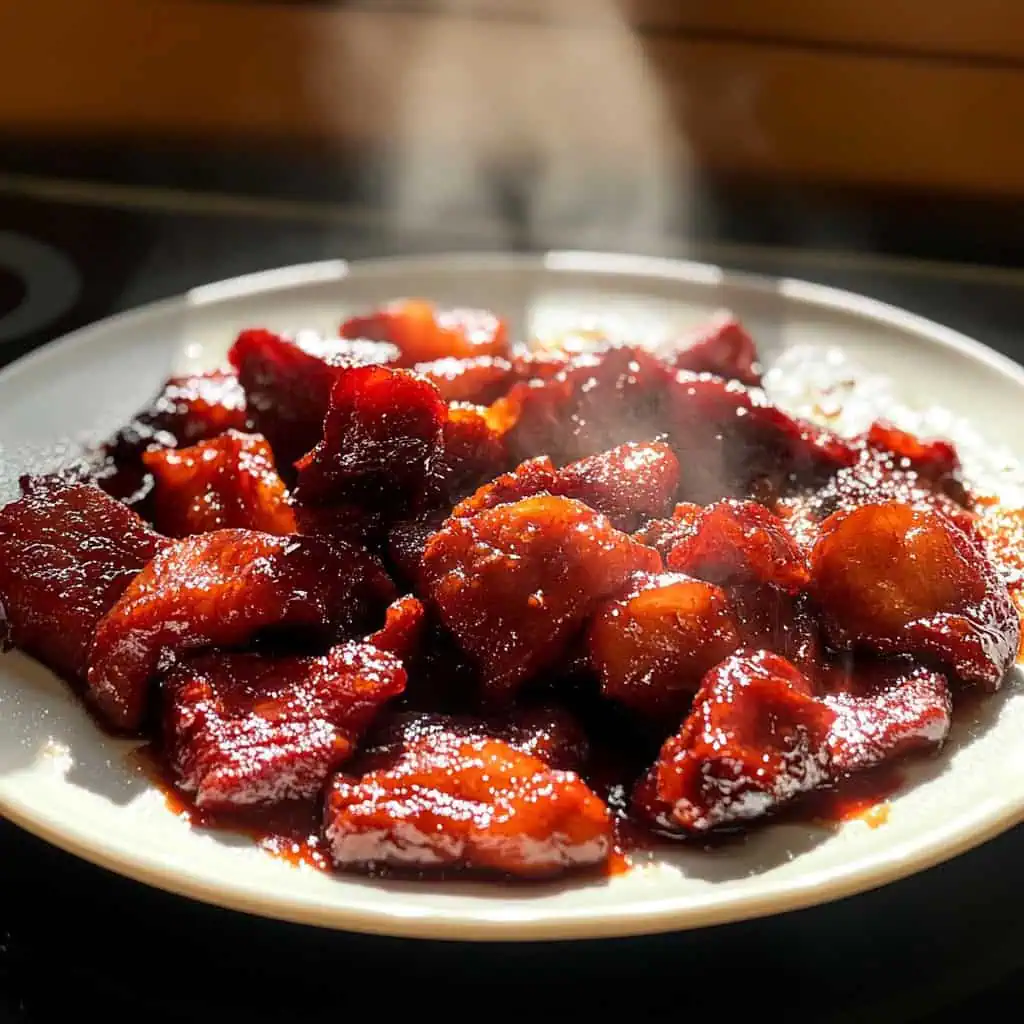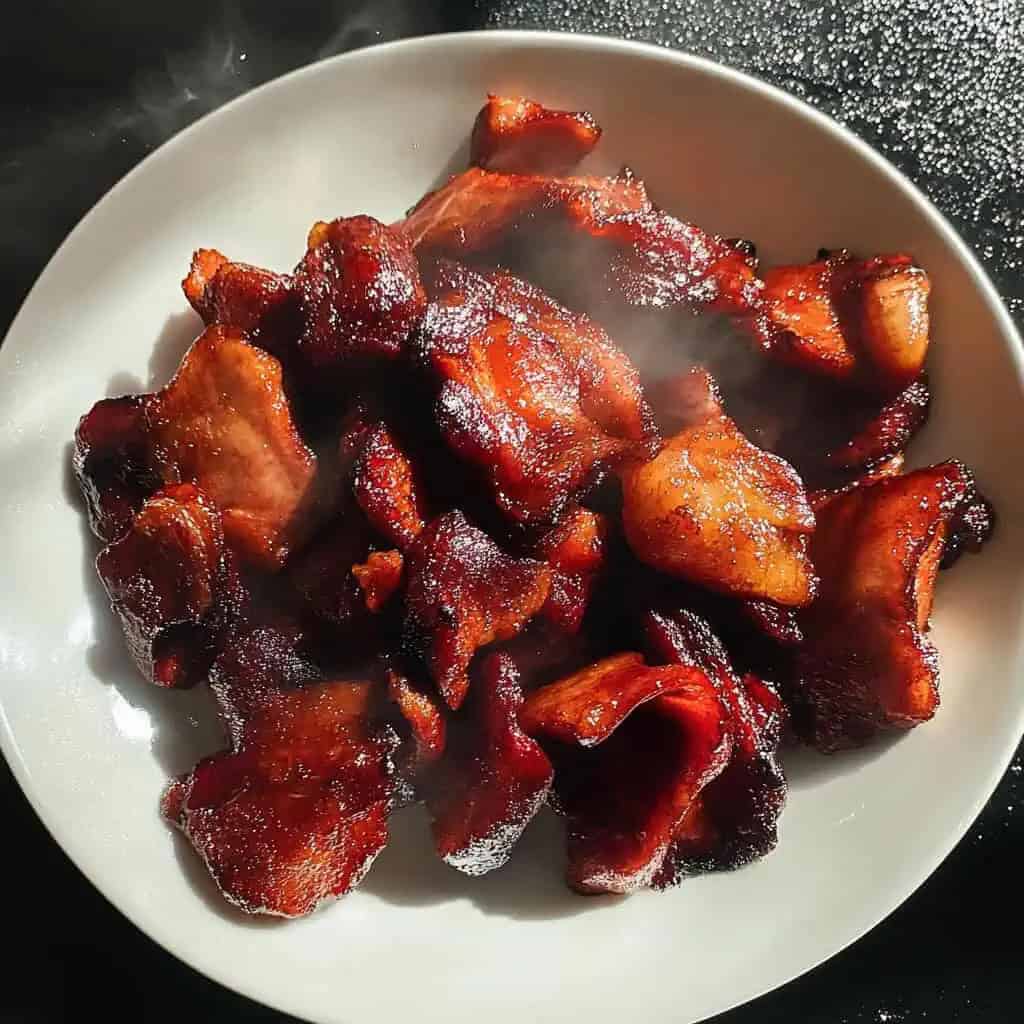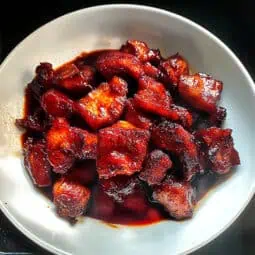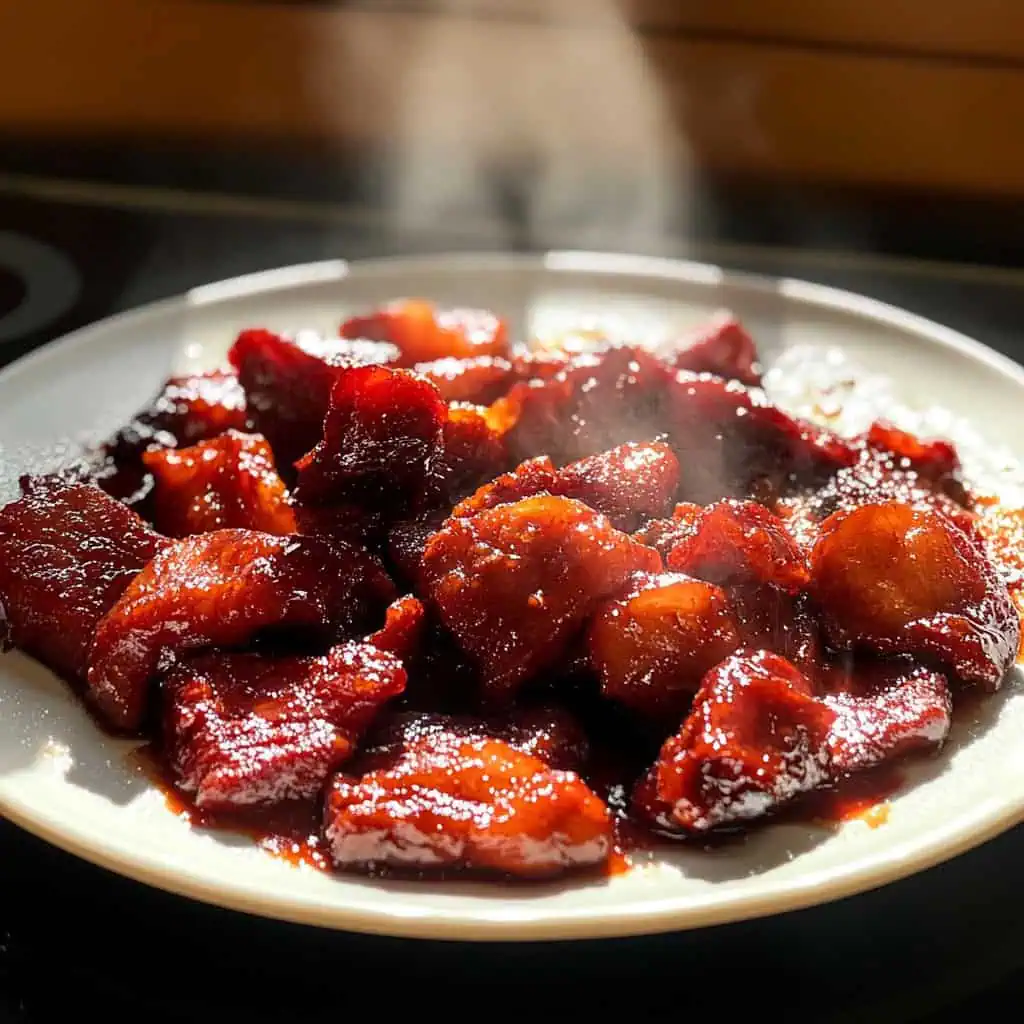A cherished Kapampangan specialty, Pork Tocino stands as a testament to Filipino culinary heritage. This homemade version bypasses commercial preservatives while maintaining the authentic sweet-savory profile that has made it a breakfast table staple throughout the Philippines.
Drawing from traditional curing techniques perfected in Pampanga, a region renowned for its pork specialties, this recipe yields perfectly caramelized meat slices that pair beautifully with garlic rice and eggs in the classic tocilog combination.
While modern methods have adapted for food safety and convenience, the dish retains its signature taste that has delighted Filipino families for generations.
Jump to:

Why You'll Love This Recipe
- Authentic Kapampangan recipe passed down through generations
- No artificial preservatives unlike store-bought versions
- Can be made in bulk and frozen for future use
- Perfect balance of sweet and savory flavors
- Tender, caramelized meat that's better than commercial versions
- Versatile - can be served for breakfast, lunch, or dinner
- Cost-effective compared to store-bought tocino
Ingredients
The ingredients in this tocino recipe are carefully chosen to create the perfect balance of flavors and textures. Pork butt provides the ideal fat-to-meat ratio that keeps the tocino juicy when cooked. Sugar creates the signature sweet profile and helps with caramelization, while salt enhances flavors and acts as a preservative.
Garlic powder adds the distinctive Filipino savory note without burning (as fresh garlic might). The optional pineapple juice contains natural enzymes that tenderize the meat, while atsuete provides color without artificial additives.
Together, these ingredients create an authentic tocino that's sweet, savory, tender, and naturally preserved.

- 2 pounds pork butt (kasim), sliced to ¼-inch thick
- 1 cup sugar
- 1 tablespoon salt
- 1 tablespoon garlic powder
- ¼ teaspoon black pepper
- 2 drops red food coloring (optional)
Optional Flavor Enhancers:
- 2 tablespoons pineapple juice (for tenderizing)
- 1 tablespoon anise wine (for aroma)
- 1 teaspoon atsuete powder (natural food coloring)
Equipment
- Sharp knife: For precise slicing of the pork into thin, even pieces
- Glass or non-reactive container: For marinating the meat safely without chemical reactions
- Heavy-bottom skillet or pan: For even heat distribution during cooking, ensuring perfect caramelization
- Meat mallet: For tenderizing thicker pieces of meat to ensure uniform cooking
- Measuring cups and spoons: For accurate measurements of ingredients to achieve the perfect flavor balance
- Food-grade gloves: For protecting hands while massaging the marinade into the meat

How To Make
- Take the pork out of the fridge 30 minutes before starting. This helps it cook evenly later. While waiting, prepare your marinade ingredients and get your tools ready.
- Slice your pork butt into thin pieces, about ¼-inch thick. Cut against the grain – this means cutting across the meat lines, not parallel to them. Your slices should look like little rectangles, not long strips. If some pieces are thicker than others, gently pound them with a meat mallet until they're even.
- Mix your marinade in a bowl: combine sugar, salt, garlic powder, black pepper, and red food coloring if you're using it. Add your sliced pork and massage everything together with your hands for 5 minutes. Really work the marinade into each piece of meat. Every slice should be well-coated with the mixture.
- Put your marinated meat in a container with a tight lid or a zip-top bag. Place it in the refrigerator and let it cure for at least 8 hours, but overnight is best. Don't leave it for more than 24 hours.
- When you're ready to cook, take out your marinated pork and put it in a pan. Add 1 cup of water and turn the heat to medium. Let it simmer with the lid on until the meat is tender and most of the water has evaporated – this usually takes about 15-20 minutes.
- Once most of the water is gone, add 2 tablespoons of cooking oil. Keep cooking and stirring until the meat starts to caramelize and turn golden brown around the edges. This should take about 5-7 minutes. You'll know it's done when the edges are slightly crispy and darkened, but the meat is still juicy inside.
- Let your tocino rest for 5 minutes before serving. This keeps the meat juicy. Serve hot with garlic fried rice and a sunny-side-up egg for traditional tocilog. Don't forget to put some chopped tomatoes and vinegar on the side.

Tips from Lola's Kitchen
- Slice thickness matters: Always slice meat against the grain and keep slices uniform at about ¼-inch thickness for the perfect texture.
- Hand massage technique: Don't skip the massage step - spending a full 5 minutes massaging the marinade into the meat allows for deeper flavor penetration.
- Marination timing: While overnight is ideal, don't exceed 24 hours as the meat can become too salty and the texture may deteriorate.
- Two-step cooking method: The initial steaming with water tenderizes the meat while the second dry-heat stage creates that signature caramelization.
- Rest before serving: Always let the cooked tocino rest for 5 minutes before serving to allow juices to redistribute throughout the meat.
- Cook in batches: Don't overcrowd the pan when cooking – if making a large batch, cook in portions to ensure proper caramelization.
- Save the marinade: The liquid released during cooking contains concentrated flavors – let it reduce to create the glossy coating that tocino is famous for.
Substitutions
- Pork cut alternatives: While pork butt/shoulder is traditional, you can use pork belly (liempo) for a richer result or pork loin for a leaner version (reduce cooking time for loin).
- Sweetener options: Replace white sugar with brown sugar or muscovado for deeper caramel notes and additional minerals.
- Natural coloring: Instead of artificial red food coloring, use atsuete powder (annatto), paprika, or even a tablespoon of banana ketchup for the signature reddish hue.
- Tenderizing agents: No pineapple juice? Use 2 tablespoons of apple cider vinegar or the juice from half a grated apple instead.
- Garlic alternatives: Replace garlic powder with 4-5 cloves of freshly minced garlic for more intense flavor, or use garlic salt (reduce the regular salt accordingly).
- Meat alternatives: This marinade works wonderfully with chicken thighs (reduce marinating time to 6 hours) or even firm tofu (marinate for just 2 hours) for vegetarian options.
Troubleshooting
- Tocino is too sweet: Balance excessive sweetness by serving with a spicy vinegar dipping sauce, or for your next batch, reduce sugar by 25% and increase salt slightly.
- Meat is tough after cooking: Either the slices were too thick, or the initial simmering phase was rushed. Ensure uniform ¼-inch slices and allow sufficient simmering time with water.
- Not getting proper caramelization: Make sure all water has completely evaporated before adding oil. Also check that your heat isn't too low during the final cooking stage.
- Too salty: If your tocino turned out too salty, serve it with plain steamed rice instead of garlic rice, and for next time, increase the ratio of sugar to salt.
- Burning before cooking through: Your heat is likely too high. Start with medium-low heat when adding the water, and don't rush the process.
- Marinade not penetrating the meat: Make sure you're really massaging the mixture into the meat for the full 5 minutes, and score thicker pieces slightly to help absorption.
Storage & Reheating
Fresh Storage:
- Marinated (uncooked): Keep refrigerated for up to 3 days in an airtight container.
- Cooked tocino: Refrigerate for 3-4 days in a sealed container after cooling completely.
Freezer Storage:
- Marinated (uncooked): Divide into portion-sized freezer bags, remove air, and freeze for up to 3 months.
- Cooked tocino: Once cooled, store in airtight containers or freezer bags for up to 2 months.
Thawing:
- Move from freezer to refrigerator 24 hours before cooking or reheating.
- For quick thawing, place sealed package in cold water, changing water every 30 minutes.
Reheating Methods:
- Stovetop (best method): Add 2-3 tablespoons of water to a pan, add tocino, cover and heat on medium-low for 5 minutes. Remove lid, allow water to evaporate, then add a touch of oil to re-crisp the edges.
- Microwave: Place tocino in a microwave-safe dish, cover with a damp paper towel, heat on medium power for 1-2 minutes. Check and continue in 30-second intervals if needed.
- Air fryer: 350°F for 3-4 minutes for a quick reheat with crispy edges.
- Always reheat to an internal temperature of 165°F (74°C) for food safety.

FAQ
Can I make tocino without any food coloring?
Yes, absolutely! The color is purely aesthetic. For a natural reddish tint, use annatto/atsuete powder, paprika, or even a tablespoon of banana ketchup in your marinade. Some home cooks simply omit coloring altogether.
Why is my homemade tocino not as red as store-bought versions?
Commercial versions often use artificial food coloring in higher quantities than are practical (or necessary) for home cooking. Natural versions will have a more subdued color that ranges from light pink to reddish-brown after cooking.
Can I freeze the marinated meat right away?
Yes! In fact, freezing immediately after marinating is an excellent way to prep multiple batches. Portion the marinated meat into meal-sized freezer bags, press out the air, and freeze flat for easy storage and quicker thawing.
How do I know when tocino is properly caramelized?
Look for edges that are slightly crispy and dark golden brown, while the center remains juicy. The sugar in the marinade should form a glossy coating on the meat, and there should be no liquid puddles in the pan.
Is pork tocino healthy?
Traditional tocino is meant to be an occasional treat rather than an everyday food due to its sugar and salt content. For a healthier version, use lean pork loin, reduce the sugar by half, and substitute part of it with pineapple juice for natural sweetness.
Can children eat tocino?
Yes, tocino is safe for children to eat when properly cooked. Many Filipino children grow up enjoying tocino as part of their breakfast. You may want to reduce the sugar and salt slightly when preparing it for young children.
What's the difference between tocino and bacon?
While both are cured pork products, bacon is salt-cured and often smoked, resulting in a savory, smoky flavor. Tocino is sweet-cured with sugar as the predominant flavor, creating a sweet-savory caramelized profile without smokiness.
Can I make a large batch of tocino marinade and store it for future use?
Yes, you can prepare the dry marinade mix (sugar, salt, garlic powder, and spices) in bulk and store it in an airtight container at room temperature for up to 3 months. Just add the liquid components when you're ready to marinate the meat.
Related
Looking for other recipes like this? Try these:

Homemade Pork Tocino
Equipment
- Sharp knife Para sa maayos na paghiwa (For precise slicing)
- Glass or non-reactive container Para sa pagmamarina (For marinating)
- Heavy-bottom skillet or pan: Para sa magandang pagkaluto (For even cooking)
- Meat mallet Para sa pagpapalambot ng karne (For tenderizing)
- Measuring cups and spoons Para sa tumpak na sukat (For accurate measurements)
- Food-grade gloves Para sa paghahalo ng marinada (For mixing marinade)
Ingredients
For the Marinade
- 2 pounds pork butt kasim, sliced to ¼-inch thick
- 1 cup sugar
- 1 tablespoon salt
- 1 tablespoon garlic powder
- ¼ teaspoon black pepper
- 2 drops red food coloring optional
Optional Flavor Enhancers
- 2 tablespoons pineapple juice for tenderizing
- 1 tablespoon anise wine pang-aromatiko/for aroma
- 1 teaspoon atsuete powder natural food coloring
Instructions
- Take the pork out of the fridge 30 minutes before starting. This helps it cook evenly later. While waiting, prepare your marinade ingredients and get your tools ready.
- Slice your pork butt into thin pieces, about ¼-inch thick. Cut against the grain – this means cutting across the meat lines, not parallel to them. Your slices should look like little rectangles, not long strips. If some pieces are thicker than others, gently pound them with a meat mallet until they're even.
- Mix your marinade in a bowl: combine sugar, salt, garlic powder, black pepper, and red food coloring if you're using it. Add your sliced pork and massage everything together with your hands for 5 minutes. Really work the marinade into each piece of meat. Every slice should be well-coated with the mixture.
- Put your marinated meat in a container with a tight lid or a zip-top bag. Place it in the refrigerator and let it cure for at least 8 hours, but overnight is best. Don't leave it for more than 24 hours.
- When you're ready to cook, take out your marinated pork and put it in a pan. Add 1 cup of water and turn the heat to medium. Let it simmer with the lid on until the meat is tender and most of the water has evaporated – this usually takes about 15-20 minutes.
- Once most of the water is gone, add 2 tablespoons of cooking oil. Keep cooking and stirring until the meat starts to caramelize and turn golden brown around the edges. This should take about 5-7 minutes. You'll know it's done when the edges are slightly crispy and darkened, but the meat is still juicy inside.
- Let your tocino rest for 5 minutes before serving. This keeps the meat juicy. Serve hot with garlic fried rice and a sunny-side-up egg for traditional tocilog. Don't forget to put some chopped tomatoes and vinegar on the side.
- For any leftovers, let them cool completely before storing. They'll keep in the fridge for 3-4 days. When you want to reheat, just add a tiny splash of water to the pan to keep the meat moist while it warms up.
Tips from Lola's Kitchen
- Always slice meat against the grain for tenderness
- Don't skip the massage step - it helps the meat absorb flavors
- Save the marinade for cooking - it creates the signature caramelization
- Let meat rest at room temperature for 5 minutes before serving
- For best results, use meat with some fat marbling
Nutrition
The Story Behind Pork Tocino
Deep in the heart of Pampanga, known as the Culinary Capital of the Philippines, lies the rich history of Pork Tocino. This beloved Filipino breakfast staple traces its roots to the pre-refrigeration era when ancient preservation techniques shaped the region's distinctive cuisine. While Spanish colonizers introduced curing methods throughout the Philippines, it was the Kapampangans who perfected the art of tocino-making, creating a unique balance of sweet and savory flavors that would become a national treasure.
Originally, tocino was born out of necessity. The word itself comes from the Spanish term "tocino," which refers to cured meat or bacon. However, Filipino ingenuity transformed this preservation method into something entirely unique. Traditional Kapampangan burong babi (fermented pork) was developed as a way to extend meat's shelf life in the tropical climate, using natural fermentation processes that created a distinctive tangy flavor profile that would later evolve into the sweeter version we know today.
What sets Pampanga's tocino apart is its careful preparation method. While other regions adopted similar curing techniques, Kapampangan tocino makers pioneered the precise balance of garlic, salt, and sugar that gives the meat its signature taste. Historically, saltpeter (salitre) was used as a preservative and to give the meat its reddish hue, but modern home cooking has evolved to eliminate artificial preservatives while maintaining the dish's beloved characteristics.
The rise of tocilog—a portmanteau of tocino, sinangag (garlic fried rice), and itlog (egg)—in Filipino breakfast culture cemented tocino's place in Philippine cuisine. This combination became so popular that it transcended its origins as a preservation method to become a sought-after dish in its own right, featured in everything from humble carinderias to high-end Filipino restaurants worldwide. Today, while commercial versions abound, many Filipino families still pride themselves on their homemade tocino recipes, passed down through generations.
In modern Filipino kitchens, the art of making tocino has adapted to contemporary food safety standards while preserving its essential character. The traditional room-temperature fermentation has given way to refrigerated curing, and natural ingredients have replaced artificial preservatives. Yet, the fundamental technique of marinating thinly sliced pork in a carefully balanced mixture of sweet and savory ingredients remains unchanged, proving that some culinary traditions are timeless.










Comments
No Comments